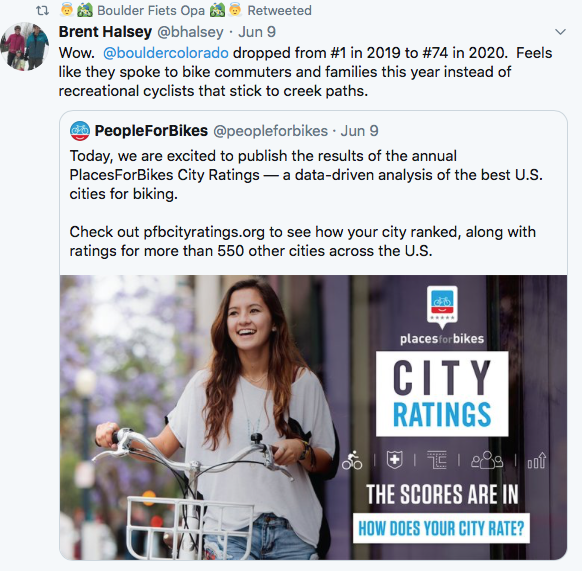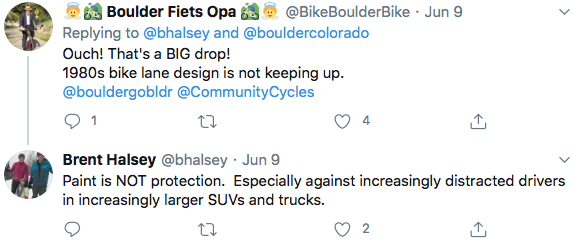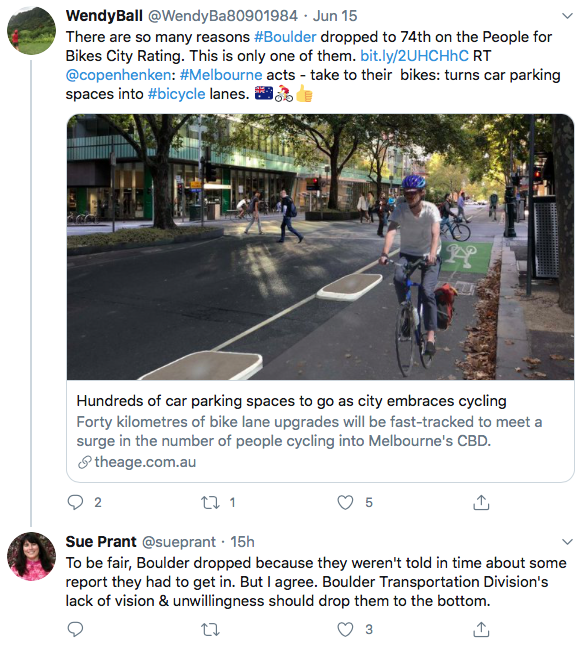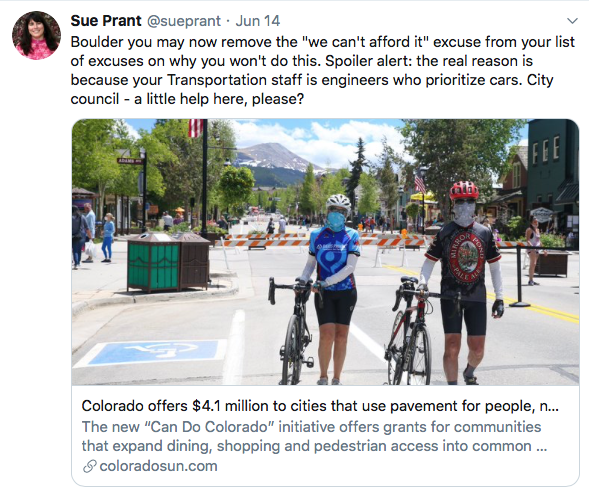People for Bikes will redo cycling city rankings to include Boulder’s missing stats
Tuesday, June 16, 2020
When People for Bikes released its annual list of best cities for cycling, it was surprising to not see Boulder in the top 20. Or the top 50. The People’s Republic, last year’s list-topper, had fallen all the way to No. 74.
No one was more surprised than Boulder’s transportation staff. They’d never seen the typical, multiple calls for submission, according to David Kemp, senior transportation planner.
“We just never got any kind of word that this was in the works,” Kemp said. “Thoughts about the city rating went by the wayside” — particularly when COVID-19 hit four months ago — “until it was announced that the ratings have come out. We were like, oh, the ratings have come out.”
People for Bikes, a Boulder-based nonprofit, has a system that flags when its notification emails bounce back. Boulder’s didn’t, so staff assumed all was well. It wasn’t until the nonprofit sent the city an email about the rankings that the two got to talking.
“It looks like we had a technical glitch,” said Kyle Wagenschutz, People for Bikes’ director of local innovation. “We’re not quite sure what caused it.”
Boulder will submit info, and the Places for Bikes list will be redone, Wagenschutz said Friday. Updated results should be released in July.
Read the current rankings at cityratings.peopleforbikes.org
It’s not uncommon for cities to get left out, Wagenschutz said. Some bigger cities with well-established infrastructure routinely choose not to submit applications. The system is built so that participation isn’t strictly necessary: People for Bikes relies on census data and other sources that aren’t self-submitted.
Boulder’s 72 miles of multi-use path meant it ranked No. 4 for existing network. Where it really fell short is the acceleration category: What is being done to improve infrastructure and get more people riding? That’s one where city-reported data is important.
The 0.7 score the city received is not reflective of all the work that’s going on, Kemp said. “2019 was actually a pretty big year for us.”
There were no cyclist fatalities — though serious injuries increased, a trend Wagenschutz said was consistent nationwide — the transportation master plan was updated, the 13th Street underpass opened and the 13th Street neighborhood green streets improvements completed. Improvements to the 30th Street and Colorado underpass and protected intersection are ongoing, three streets are slated for buffered bike lanes, and the Foothill overpass is being replaced with an underpass.
Despite all that work and the submission snafu, some residents were all too ready to believe that Boulder really had fallen behind its peers in innovating. The transportation department has been roundly criticized for timidity in recent months: first, for not planning a separated bike lane as part of the North Broadway redo, then for failing to close streets to cars during COVID, which dozens of communities across the world have done. Colorado is actually paying cities to open roadways for recreation.
Kemp is aware of the unrest. He encountered similar attitudes in cities where he worked previously (Fort Collins; Davis, Calif.; Flagstaff, Ariz.) Pedestrians and cyclists are at the top of the transportation hierarchy in Boulder, he said, and the city has been building out its bike network since the 1970s.
“People have high expectations,” Kemp said. And when every transportation innovation in any city can be found online, “it’s kind of like keeping up with the Joneses.”
Wagenschutz agrees. “My observation is that if we tell a city they’re doing really well, everybody in that city comes out of the woodwork to say how it’s not going well,” he said. “If we tell a city they’re doing poorly, people say we’re doing well.”
Still, Kemp knows there is work to be done, particularly with on-street bike facilities. Ideas are plentiful, but the budget is not. As residents’ reactions show, painting a lane on the side of the road no longer cuts it. Separated bike lanes are expensive.
“There’s no more low-hanging fruit in Boulder,” he said.
While that may be true, there is room for improvement. Even if Boulder is among the most bike-friendly cities in the U.S., it falls short on a global scale. San Luis Obispo, which led People For Bikes’ 2020 list, received a 3.5 on a 5-point scale — an acknowledgement, Wagenschutz said, that even the best American cycling infrastructure pales in comparison to European offerings.
“There are even better places to ride than any place here,” he said. “There’s still even a runway for a Boulder, for a San Francisco, for a New York City to enter the upper echelons of cycling worldwide.”
Changing public perception may be part of that work, Wagenschutz said.
“Perceptions are reality even if (they’re) not truth. Sometimes we have to acknowledge that having 100 miles of bike lanes maybe on paper solves the problem, but if we haven’t shifted the public opinion or perception… that’s what cities might want to focus on.”
— Shay Castle, boulderbeatnews@gmail.com, @shayshinecastle
Want more stories like this, delivered straight to your inbox? Click here to sign up for a weekly newsletter from Boulder Beat.
Transportation bicycle bikes COVID COVID-19 cycling infrastructure nonprofit pedestrians People For Bikes transportation







1 Comment Leave a comment ›